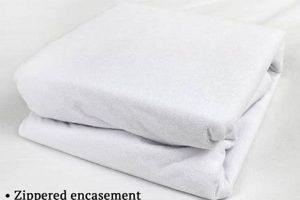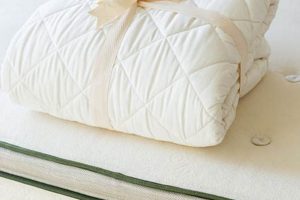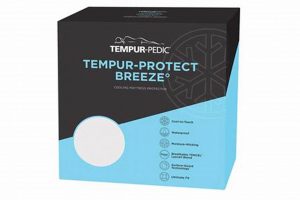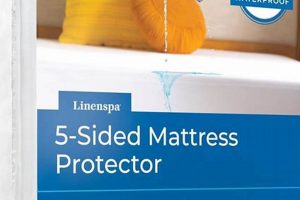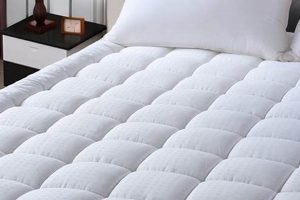This product provides a barrier against spills, stains, dust mites, and allergens, thereby safeguarding the underlying sleeping surface. It is typically a fitted sheet style covering designed to encase the mattress. An example would be a waterproof cover designed to prevent liquids from penetrating the mattress during accidental spills.
The value of such a protective layer lies in its ability to prolong the lifespan of the mattress. By preventing contamination and wear, it helps maintain the mattress’s integrity and hygiene over time. Historically, simpler forms of mattress protection existed, but modern versions incorporate advanced materials and technologies for enhanced impermeability and comfort.
The following sections will explore the various types of this protective bedding, including materials, features, care instructions, and factors to consider when selecting the most appropriate option for individual needs and preferences.
Practical Guidance for Optimal Use
The subsequent recommendations aim to maximize the effectiveness and longevity of the product, ensuring consistent protection and hygiene for the underlying mattress.
Tip 1: Select the Correct Size: Ensure the protector precisely matches the mattress dimensions (Twin, Twin XL, Full, Queen, King, Cal King). An ill-fitting protector may be ineffective or cause discomfort.
Tip 2: Prioritize Waterproof Construction: Opt for waterproof models, particularly if concerns exist regarding spills or incontinence. Look for labels indicating waterproof or water-resistant properties.
Tip 3: Consider Material Composition: Microfiber, cotton, or hypoallergenic materials are suitable for individuals with sensitivities. The material should be breathable to prevent overheating.
Tip 4: Implement Regular Cleaning: Follow the manufacturer’s instructions for washing and drying. Frequent cleaning, typically every 1-2 months, helps eliminate allergens and maintain hygiene.
Tip 5: Protect Against Punctures: Avoid placing sharp objects on the bed that could potentially puncture or tear the protective layer. This compromises its barrier function.
Tip 6: Inspect Regularly for Damage: Periodically examine the protector for any signs of wear and tear, such as rips, tears, or delamination. Replace the protector if damage is present.
Tip 7: Use with Fitted Sheets: Place a fitted sheet over the protector to enhance comfort and prevent direct contact with the waterproof layer. This also provides an additional layer of protection.
Adhering to these recommendations optimizes performance, enhances the cleanliness of the sleep environment, and extends the useful life of the mattress.
The following sections will provide information on maintaining and caring for the bedding and what steps to take when damage occurs.
1. Waterproof Barrier
The waterproof barrier is a fundamental characteristic of a quality mattress protector. Its integrity directly correlates to the protector’s ability to shield the underlying mattress from liquid damage, thereby preserving its condition and extending its lifespan.
- Hydrophobic Layer Composition
The waterproof capability typically stems from a polyurethane film or membrane laminated to the fabric. This layer impedes liquid penetration while permitting air circulation, crucial for breathability and preventing moisture buildup. Ineffective or damaged hydrophobic layers negate the protector’s primary function.
- Seam Integrity
Seams represent potential weak points in the waterproof barrier. Heat sealing or specialized stitching techniques are necessary to ensure that liquids cannot penetrate through these junctions. Substandard seam construction compromises the overall waterproofing effectiveness.
- Performance Under Stress
A reliable waterproof barrier must withstand repeated washing, stretching, and abrasion without losing its integrity. Low-quality materials may crack or delaminate, rendering the protector ineffective after only a few uses. Durability testing is essential to assess long-term performance.
- Consequences of Failure
If the waterproof barrier fails, spills and bodily fluids can saturate the mattress, leading to staining, odor, and the proliferation of mold and bacteria. This necessitates professional cleaning or, in severe cases, mattress replacement, highlighting the critical importance of a robust waterproof barrier.
The efficacy of the waterproof barrier directly influences the overall utility and value of the protector. Selection requires careful consideration of material composition, construction techniques, and demonstrated performance to ensure adequate protection against liquid damage. Choosing a protector without a reliable barrier leaves the mattress vulnerable and defeats the purpose of using a protector.
2. Allergen Protection
Allergen protection, as it relates to mattress protectors, focuses on minimizing exposure to common indoor allergens that accumulate within mattresses. The design and materials of a protector play a significant role in creating a barrier against these allergens, promoting a healthier sleep environment.
- Dust Mite Barrier
Dust mites are a primary allergen found in mattresses. A tightly woven mattress protector fabric prevents dust mites from penetrating and colonizing the mattress core. Impermeable barriers are most effective, as they physically block the mites. A loosely woven protector offers minimal dust mite protection.
- Pet Dander Reduction
For pet owners, dander is a significant allergen source. A protector creates a surface that is easier to clean, thereby reducing the accumulation of pet dander. Select protectors with smooth, non-porous surfaces for effective removal of pet dander through regular cleaning.
- Mold and Mildew Prevention
Moisture accumulation within a mattress can lead to mold and mildew growth, both of which are allergens. A waterproof protector prevents moisture from reaching the mattress core, thus inhibiting mold and mildew proliferation. Breathability is also important to manage humidity levels.
- Hypoallergenic Materials
Certain materials used in mattress protectors are inherently hypoallergenic. Synthetic materials, such as microfiber, are less likely to harbor allergens compared to natural fibers like cotton. Individuals with sensitivities should opt for protectors explicitly labeled as hypoallergenic to minimize allergic reactions.
The integration of these allergen protection measures within a mattress protector provides a valuable function in promoting a cleaner, healthier sleep environment. Selecting a protector with robust allergen barrier properties is particularly beneficial for individuals with allergies or asthma. Regular maintenance, including washing the protector according to manufacturer instructions, is essential to sustain its effectiveness.
3. Mattress Longevity
The lifespan of a mattress is directly correlated with the level of protection afforded by a quality mattress protector. A mattress represents a significant financial investment; its premature degradation necessitates costly replacement. Protectors mitigate the primary factors contributing to mattress wear and tear, thereby extending its usable life. For instance, without a protective barrier, accumulated spills, sweat, and body oils penetrate the mattress fibers, causing irreversible staining, odor, and structural breakdown over time. A protector acts as a shield against these elements.
Furthermore, the presence of dust mites and other allergens within a mattress core can degrade its integrity and pose health risks. Regular cleaning of a mattress interior is impractical; however, a protector provides a removable, washable layer that contains these allergens, preventing them from becoming deeply embedded within the mattress. This contributes to both the hygiene and structural soundness of the mattress. Consider a scenario where a child wets the bed; without a protector, the liquid would soak into the mattress, creating a breeding ground for bacteria and potentially compromising the mattress’s support structure. The protector contains the spill, preventing long-term damage.
In summary, the strategic application of a mattress protector safeguards against various sources of damage and contamination, thereby positively influencing mattress longevity. This represents a practical and cost-effective approach to preserving the investment in the sleep environment and ensuring optimal hygiene. Failure to utilize a protector increases the risk of premature mattress degradation, leading to potential financial burden and compromised sleep quality.
4. Breathability
Breathability, in the context of mattress protectors, refers to the material’s capacity to allow air and moisture vapor to pass through. The connection between this attribute and a mattress protector is significant, impacting user comfort and the long-term integrity of the mattress itself. A non-breathable protector traps heat and moisture, leading to discomfort, increased perspiration, and potential mold or mildew growth within the mattress. Conversely, a breathable protector facilitates airflow, dissipating heat and wicking away moisture, thus maintaining a more comfortable and hygienic sleep environment. For example, a protector constructed with a polyurethane layer, while providing waterproofing, can significantly impede breathability unless specifically engineered with micro-pores to allow vapor transmission.
The importance of breathability extends beyond mere comfort. A mattress that retains moisture provides an ideal environment for dust mites and bacteria to thrive, exacerbating allergies and potentially causing respiratory issues. Breathable protectors help regulate temperature, preventing overheating, a common cause of sleep disruption. For instance, individuals residing in warmer climates or those prone to night sweats particularly benefit from highly breathable protectors. Certain materials, such as Tencel or specific blends of cotton, offer enhanced breathability compared to traditional polyester-based protectors.
In conclusion, breathability is a critical component in mattress protector design, directly influencing comfort, hygiene, and the lifespan of the mattress. Selecting a protector that balances waterproof functionality with adequate breathability is essential for creating a healthy and comfortable sleep environment. While waterproof features safeguard against spills, a failure to prioritize breathability can negate these benefits, leading to a less desirable outcome. Therefore, consumers should carefully evaluate the materials and construction of mattress protectors, focusing on vapor permeability alongside waterproof properties.
5. Ease of Care
Ease of care is a critical attribute directly impacting the practical value and long-term utility of a mattress protector. The frequency with which a protector is laundered correlates to its continued effectiveness in allergen and spill protection. Complex cleaning procedures or delicate materials negate the intended benefits by discouraging regular maintenance. A protector that necessitates professional cleaning, for instance, will likely be cleaned less frequently than one that can be machine washed and dried, thereby diminishing its hygienic properties.
The composition of the material and the design of the protector determine its ease of care. Protectors constructed from machine-washable and dryer-safe fabrics, such as polyester blends, offer a significant advantage in terms of convenience. Conversely, protectors with specialized waterproof membranes or those requiring delicate washing cycles present practical challenges. For example, a protector requiring air drying may take an extended period to fully dry, potentially disrupting bed-making routines. Specific instructions, such as avoiding bleach or high heat, further influence the care process and potential for damage. The presence of zippers or intricate closures can also add complexity to the cleaning process.
In summary, ease of care is not merely a convenience; it is a crucial determinant of the long-term effectiveness of a mattress protector. Choosing a protector with straightforward cleaning requirements ensures consistent hygiene, preserves its protective qualities, and ultimately extends the lifespan of both the protector and the underlying mattress. This consideration should be a primary factor in the selection process, balancing protective features with practical maintenance needs. A lack of attention to ease of care can result in decreased protector performance and a diminished return on investment.
6. Secure Fit
A secure fit is paramount for any mattress protector, as it directly influences the protector’s efficacy and the sleeper’s comfort. If a mattress protector shifts or bunches, it compromises the intended barrier against allergens, spills, and dust mites. Furthermore, movement can cause noise and discomfort, disrupting sleep. A poorly fitted protector may also experience accelerated wear and tear due to constant friction. For instance, a protector that is too loose is more likely to develop rips and tears compared to one that fits snugly and remains in place.
The design of a secure-fitting protector typically incorporates elasticized edges, deep pockets, or anchoring straps. Deep pockets accommodate thicker mattresses, while elasticized edges ensure a snug fit across the mattress surface. Anchoring straps provide additional security, particularly for adjustable beds or mattresses subject to frequent movement. The effectiveness of these features depends on the quality of the materials and construction. Ineffective elastic can stretch out over time, rendering the protector loose and ineffective. Conversely, durable, high-quality elastic and robust construction contribute to a lasting secure fit. Consider the case of a restless sleeper: a secure fit ensures continuous protection throughout the night, even with significant movement.
In conclusion, a secure fit is not merely an aesthetic consideration; it is a fundamental component of mattress protector functionality. Failure to achieve a secure fit negates many of the protector’s intended benefits, undermining its value and potentially compromising sleep quality. Selection of a protector should prioritize features that contribute to a secure and lasting fit, ensuring both comfort and consistent protection. The ideal protector should remain firmly in place, providing a reliable barrier without shifting or bunching, regardless of sleeping habits or mattress type.
7. Material Quality
Material quality is a critical determinant of the overall performance, durability, and suitability of a mattress protector. The selection of materials directly impacts the protector’s ability to perform its core functions: safeguarding the mattress from spills, allergens, and wear, while simultaneously providing comfort and breathability. Substandard materials may compromise these functions, negating the benefits of using a protector.
- Waterproof Membrane Integrity
The waterproof layer, typically polyurethane or a similar membrane, must exhibit high tensile strength and resistance to delamination. Low-quality membranes may crack or separate from the fabric after repeated washing, rendering the protector ineffective. Example: A thin, inexpensive polyurethane layer is prone to tearing, especially when stretched or subjected to high heat in a dryer. High-quality materials maintain waterproof integrity even after multiple wash cycles.
- Surface Fabric Durability
The surface fabric, often cotton, polyester, or a blend, must withstand abrasion and repeated washing without pilling, tearing, or losing its shape. Inferior fabrics degrade quickly, compromising both comfort and the protector’s overall appearance. Example: A low thread count cotton fabric will wear thin and develop holes more readily than a high thread count, tightly woven fabric. Durable fabrics retain their texture and appearance over time.
- Seam Construction Strength
Seams represent potential weak points where liquids and allergens can penetrate. High-quality protectors utilize reinforced stitching and durable thread to prevent seam failure. Example: Single-stitched seams are more susceptible to tearing under stress compared to double-stitched or reinforced seams. Robust seam construction ensures that the protector remains intact and effective throughout its lifespan.
- Hypoallergenic Properties
For individuals with allergies, the hypoallergenic properties of the materials are essential. Materials certified as hypoallergenic minimize the risk of allergic reactions and irritation. Example: Some synthetic fabrics are inherently hypoallergenic, while others may require special treatments to reduce allergen content. The use of certified hypoallergenic materials ensures a safer sleep environment for sensitive individuals.
These facets underscore the direct connection between material quality and the overall utility of a mattress protector. Opting for protectors constructed from durable, high-quality materials enhances their performance, extends their lifespan, and ultimately provides superior protection for the underlying mattress. A failure to prioritize material quality can result in a compromised sleep environment and premature replacement of the protector.
Frequently Asked Questions About Mattress Protectors
The following questions address common concerns and misconceptions regarding mattress protectors, offering insights into their function, benefits, and proper usage.
Question 1: Is a mattress protector truly necessary, or is it merely an optional accessory?
A mattress protector serves a critical function in preserving the lifespan and hygiene of the mattress. It provides a barrier against spills, stains, allergens, and dust mites, all of which can compromise the integrity and sanitation of the sleeping surface. While seemingly optional, its use is strongly recommended to safeguard the significant financial investment represented by a mattress.
Question 2: What is the expected lifespan of a mattress protector, and how does its longevity compare to that of a mattress?
The lifespan of a mattress protector varies depending on material quality, construction, and usage patterns. Typically, a well-maintained protector can last for several years. However, its longevity is generally shorter than that of a high-quality mattress. Regular inspection for wear and tear is essential, and replacement should occur as needed to maintain optimal protection.
Question 3: Can a mattress protector effectively prevent bed bugs from infesting a mattress?
A mattress protector can act as a barrier against bed bug infestations, particularly if it encases the entire mattress and is specifically designed to be bed bug-proof. However, it is not a foolproof solution. Vigilance and proactive pest control measures are still necessary to prevent and eliminate infestations effectively.
Question 4: How does the breathability of a mattress protector impact sleep quality and comfort?
The breathability of a mattress protector significantly influences sleep quality. A non-breathable protector can trap heat and moisture, leading to discomfort and potentially disrupting sleep. Protectors constructed from breathable materials, such as cotton or specific synthetic blends, promote airflow and maintain a more comfortable sleep environment.
Question 5: What are the recommended cleaning and maintenance procedures for a mattress protector?
The recommended cleaning procedures vary depending on the specific material and construction of the protector. Generally, machine washing and drying are acceptable. However, following the manufacturer’s instructions is crucial to prevent damage or degradation. Regular washing, typically every one to two months, is recommended to maintain hygiene and allergen control.
Question 6: Does the type of mattress (e.g., memory foam, innerspring) influence the choice of mattress protector?
The type of mattress can influence the choice of protector. For memory foam mattresses, breathability is particularly important to prevent overheating. For thicker mattresses, deep-pocket protectors are necessary to ensure a secure fit. Considering the specific characteristics of the mattress is essential when selecting an appropriate protector.
In summary, a mattress protector offers significant benefits in terms of mattress protection, hygiene, and overall sleep quality. Careful consideration of material quality, breathability, and ease of care is essential when selecting a protector to meet individual needs and preferences.
The following section will explore specific brands and models of mattress protectors available on the market.
Assessing the Functionality of Protective Bedding
The preceding analysis underscores the importance of selecting appropriate bedding to safeguard sleeping surfaces. Considerations such as waterproof capabilities, allergen mitigation, breathability, and material durability are paramount. This comprehensive exploration provides a framework for evaluating the features and benefits associated with such a product.
The ultimate value of employing a protector lies in its ability to extend the lifespan of the underlying mattress and promote a more hygienic sleep environment. Future advancements in material science may yield even more effective and comfortable protective solutions, further enhancing the long-term benefits associated with this type of bedding.


